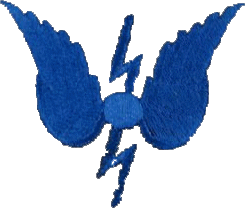|
|
|
|
|
DATE OF DESIGN |
|
1917. |
|
FREQUENCY RANGE |
|
800 -1000 kc/s. |
|
POWER SUPPLIES |
|
0.5kW DC Generator for the transmitter/receiver (a Type LB) and a 17V DC Generator for the single valve used. |
|
RANGE IN MILES |
|
N/K or N/A |
|
TYPE OF SET |
|
N/K or N/A |
|
WAVEFORM |
|
CW |
|
METHOD OF PRODUCING OSCILLATIONS |
|
SELF |
|
WHERE USED/FITTED |
|
Type 31 (which is to be replaced by the Type 45) is a single valve low powered (short range) CW transmitter. The majority of units used in the set are contained inside two boxes. The whole installation (with its associated receiver the Type LB) is then set inside a cabinet with it associated operating tools (Morse key and earphones etc).
This set was only required to transmit on one of two frequencies only which were known as the "Divisional Wave" and the "Sub-Divisional Wave". To set watch on either of these two frequencies which were close together, the Senior Ship would first transmit and all the other ships would tune their receivers accurately to the incoming signal. Then they would tune their transmitter to the 'dead space' and then their aerial coupling. The Senior Ship on the next frequency would repeat the action and the necessary transmitter/aerial settings would be noted. The aerial coupling would then be set to a point midway between the two frequencies and left. If the private ships had to shift frequency only the receiver and transmitter had to be shifted and no aerial re-tune was required. This became known as "Master Ship" tuning [later netting] and was an alternative to tuning by using a wavemeter. |
|
ASSOCIATED WAVEMETER |
|
1492B or G9 |
|
FURTHER READING |
|
|
|
IMAGES, PHOTOS, DOCUMENTS, SCHEMATICS ETC.(Click images to enlarge) |
|
|
|
NOTES. |
|
Notes on photos:
3 - This is the complete installation which includes the associated receiver, the Type LB, shown on the left. The only valve in the circuit is shown at No1, with the Morse key at No 46. No 23, which looks like an airline pilots joy-stick is the HT COS control.
4 - These are the power supplies. On the left, a small DC generator (42) for the filament of the Valve, and on the right (35), a 0.5kW DC generator for the rest of the equipment. |


